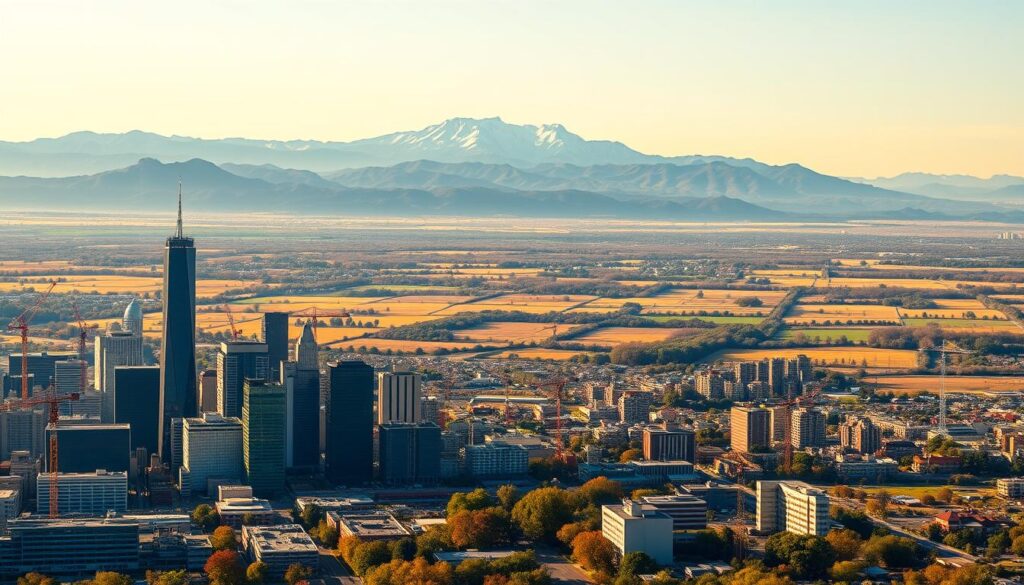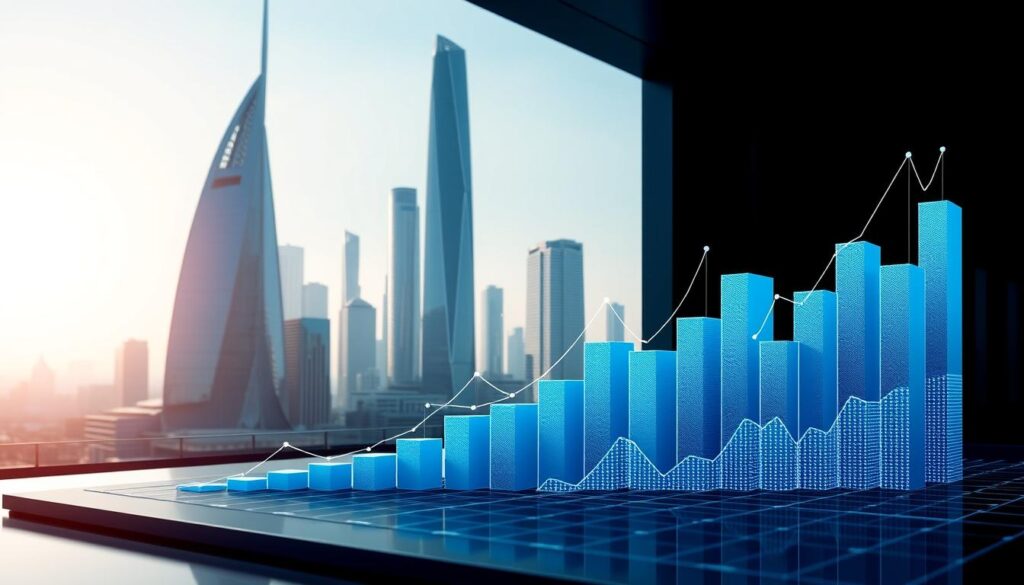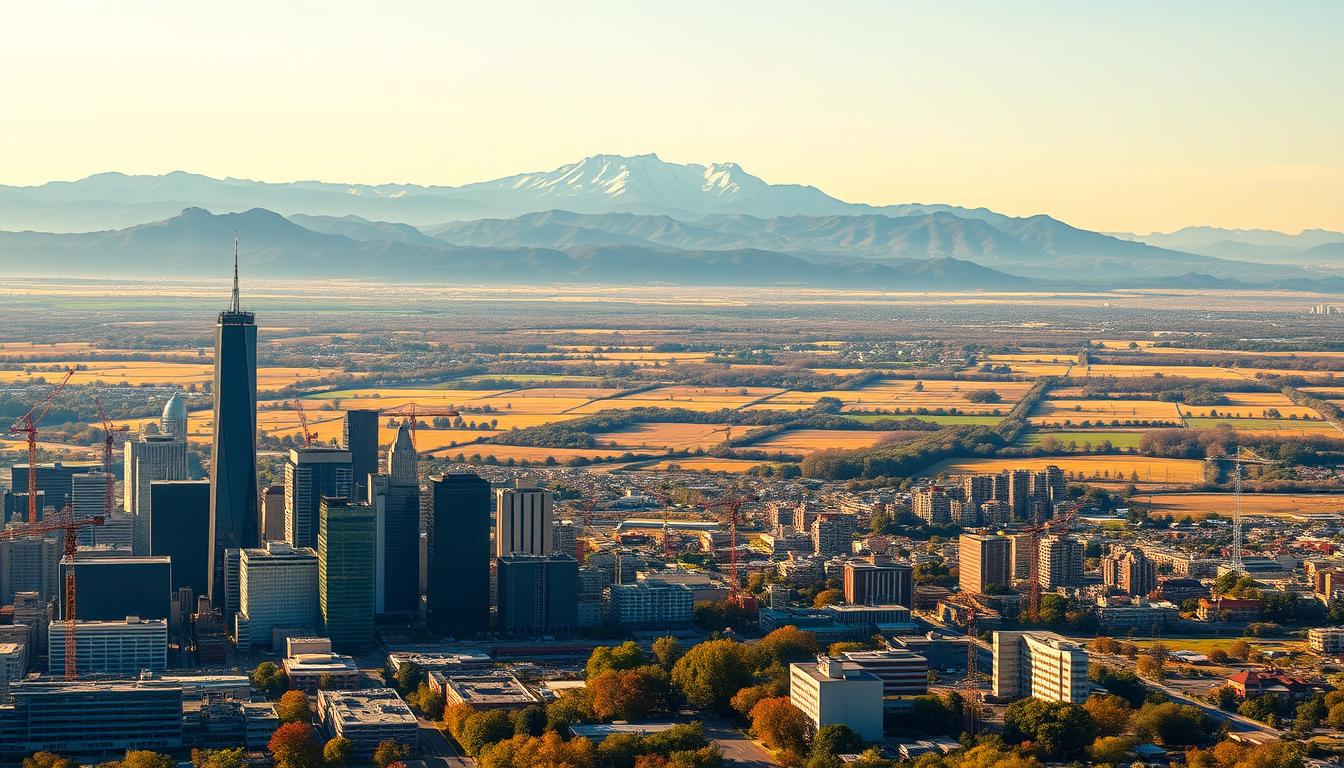The U.S. economy trends are of great interest to many. GDP growth is a key indicator of the nation’s economic health. It’s crucial for businesses, investors, and policymakers to understand these indicators to make informed decisions.
The U.S. economy has seen ups and downs in growth over the years. Various factors have influenced its path.

Exploring U.S. economy trends is essential. We must consider what drives GDP growth and the economic indicators that shape the nation’s economic landscape. By looking into these trends and insights, we can better understand the U.S. economy’s complexities and what influences its growth.
Key Takeaways
- The U.S. economy trends are influenced by various factors, including GDP growth and economic indicators.
- Understanding economic indicators is crucial for making informed decisions in business and policy.
- The U.S. economy has experienced fluctuations in growth over the years, with different factors driving GDP growth.
- Economic indicators play a significant role in shaping the nation’s economic landscape.
- Examining U.S. economy trends and insights can help us better understand the complexities of the U.S. economy.
- GDP growth is a key indicator of the nation’s economic health, and its trends are closely monitored by economists and policymakers.
Understanding Economic Growth in the U.S.
To understand economic growth in the United States, we need to look at economic indicators. These indicators show how well the economy is doing. The Gross Domestic Product (GDP) is a key indicator. It’s calculated by adding up personal spending, investments, government spending, and exports.
Productivity is also important. It shows how efficiently goods and services are made. When productivity goes up, the economy grows. Knowing about these indicators helps leaders make better choices for the economy.
- Investment in human capital and infrastructure
- Technological advancements and innovation
- Trade policies and international agreements
- Fiscal and monetary policies
Looking at these factors helps us understand how GDP and productivity are affected. This gives us a clearer picture of what drives economic growth in the U.S.
Historical Patterns of American Economic Development
The U.S. economic history is a complex mix of growth, technology, and policy. It’s key to understanding today’s economy. The U.S. has seen big growth periods, like the Industrial Revolution and after World War II.
Important events have shaped the U.S. economy. The Great Depression, World War II, and the tech boom are examples. These events have influenced the economy’s growth patterns. For instance, the Great Depression led to the New Deal, aiming to boost growth and jobs.
Several factors have driven U.S. economic growth. These include:
- Technological leaps, like the railroad and internet
- Immigration and the labor force’s growth
- Government policies, like taxes and regulations
Studying U.S. economic history offers insights into success factors. By looking at the past, we understand the economy’s complex factors. This knowledge helps make better policies for lasting growth.
Key Drivers of U.S. Economic Growth
The U.S. economy grows thanks to several key factors. Innovation is a big part of this, helping businesses make new products and services. This makes them stand out in the market competition.
Also, investing in human capital is vital. It lets workers learn new skills and become more productive.
Some main drivers of U.S. economic growth are:
- Investing in research and development boosts innovation. It leads to new technologies and products.
- Improving human capital through education and training makes workers more productive and competitive.
- Encouraging market competition by supporting entrepreneurship and reducing entry barriers drives innovation and efficiency.
By focusing on these drivers, the U.S. economy can keep growing. This creates new chances for businesses and workers. It’s important to stay ahead and adapt to changes to keep the U.S. leading globally.
The Impact of Federal Policy on Growth
The federal policy greatly affects the economy. Economic regulation is key in shaping the economic scene. The government’s choices on taxes, spending, and rules can boost or slow growth. For example, smart policies can make it easier for businesses to grow and hire more people.
Some important areas where federal policy affects growth include:
- Taxation: A fair tax system can draw in businesses and people, boosting activity.
- Regulation: Good rules protect people, workers, and the planet. They also encourage new ideas and competition.
- Government spending: Smart investments in things like roads, schools, and research can grow the economy and raise standards of living.
Investing in infrastructure is a great example of effective policy. It has created jobs and helped local economies. But, too many rules can stop innovation and slow growth. It’s important to find a balance that protects everyone while letting businesses succeed.
In summary, federal policy’s impact on growth is complex. By knowing how taxes, rules, and spending work, leaders can help businesses and people do well. This drives growth and prosperity.
Regional Economic Disparities Across States
The United States is a vast and diverse country. Economic growth varies across different regions. Factors like regional disparities, urban-rural differences, and state policies shape the economy. It’s important to understand these to promote balanced growth and address regional disparities.
Coastal regions often see higher economic growth compared to interior areas. Urban areas grow faster than rural ones. These differences are key to understanding regional disparities.
Coastal vs. Interior Economic Performance
Coastal regions, like New York and Los Angeles, drive economic growth. But, interior regions like Texas and Illinois are also growing. This shows that economic growth is not limited to coastal areas.
Urban-Rural Growth Differences
Urban areas, such as San Francisco and Seattle, grow faster than rural areas. Cities are hubs for tech and innovation. State policies, like investing in education and infrastructure, can help balance urban-rural growth.
State-Level Economic Policies
State policies are crucial in addressing regional disparities and promoting growth. By supporting businesses, investing in education and infrastructure, and encouraging innovation, states can create a more balanced economy. Examples include tax incentives, renewable energy investments, and rural development programs.
Sector-Specific Growth Analysis
The U.S. economy has many sectors, each growing differently. Knowing these growth patterns is key for businesses and investors. Industry trends greatly influence these sector growths.
Technology, healthcare, and manufacturing are major drivers of the U.S. economy. These sectors have seen big growth lately. This is thanks to tech advances, an aging population, and changes in global trade. Industry trends like digitalization, sustainability, and innovation will keep pushing these sectors forward.
Several factors help these sectors grow:
- Investment in research and development
- Adoption of new technologies
- Changes in consumer behavior
- Government policies and regulations

By studying industry trends and sector-specific growth, businesses and investors can spot growth chances. As the U.S. economy keeps changing, knowing these trends is vital for success.
International Trade and U.S. Economic Performance
The United States plays a big role in international trade. Its economy is shaped by exports and imports. Trade policies, like agreements, greatly affect its growth. Global competitiveness is key for U.S. businesses to succeed worldwide.
Agreements like NAFTA and USMCA have changed U.S. trade. They help goods and services move, boosting growth and global competitiveness. The U.S. is working on new deals to grow its international trade.
Several things help the U.S. economy stay competitive globally. These include:
- Investment in research and development
- Skilled workforce
- Infrastructure development
- Favorable business environment
These elements help U.S. businesses compete worldwide. They drive growth and increase international trade. Understanding trade agreements helps policymakers improve the U.S. economy and growth.
The Role of Small Businesses in Economic Growth
Small businesses are crucial for the US economy. They bring innovation, jobs, and community growth. Over 60% of new jobs come from them, showing their vital role.
They help the economy in many ways:
- They create jobs, lowering unemployment.
- They introduce new products and services, boosting innovation and competition.
- They invest in local communities, enhancing economic activity and development.
But, small businesses face big challenges. They struggle with limited funding, tough regulations, and big company competition. To help, we need policies that support them, like better funding, simpler rules, and tax breaks.
Supporting small businesses and entrepreneurship is key to economic growth. It creates jobs and sparks innovation. As entrepreneurship is vital in the US, we must help small businesses succeed.
In summary, small businesses are vital for economic growth. We must support them with policies and initiatives that foster entrepreneurship. This way, we can build a strong economy that benefits everyone.
Demographic Shifts and Economic Impact
The United States is seeing big changes in its population. An aging population means fewer workers and more retirees. This will strain social security and pensions, as there won’t be enough young people to support the old.
Immigration is also changing the workforce and markets. It brings new skills and ideas but also challenges in fitting in. Knowing about these changes helps businesses, leaders, and people make better choices about jobs, education, and training.

- Changes in population growth and distribution
- Shifts in labor force participation and employment rates
- Evolution of consumer spending patterns and preferences
These changes will shape the economy’s future. Businesses and people need to be ready to adapt. By understanding and acting on these shifts, we can face challenges and find new chances for growth.
Environmental Considerations in Economic Growth
The United States is growing economically, but we must think about the environment. Our natural resources are limited and need careful use. Balancing economic growth with environmental protection is a big challenge for policymakers.
To promote sustainable growth, we should invest in renewable energy and reduce waste. We also need to adopt green practices in farming and manufacturing. This way, we can protect our environment and ensure a better future for all.
Here are some ways to achieve sustainable growth:
- Implementing environmental policies that promote sustainability
- Investing in clean energy and reducing carbon emissions
- Encouraging sustainable practices in industries and communities
- Supporting research and development of new sustainable technologies
By following these steps, we can grow our economy while keeping our environment healthy. This will benefit our country for many years to come.
Future Growth Projections and Challenges
The United States economy is set to keep growing. Future growth projections show a steady rise in GDP. Yet, several economic challenges might slow this growth. These include tech disruptions and global events.
As the economy changes, we must watch for growth influencers. These are tech advancements, global happenings, and policy shifts.
Important factors for the US economy’s future include:
- Technological advancements, such as artificial intelligence and renewable energy
- Global events, such as trade agreements and geopolitical tensions
- Policy changes, such as tax reforms and regulatory updates
Despite hurdles, the US economy is ready for long-term growth. It has a strong labor market and a well-developed financial system. To meet future growth projections, the US must tackle issues like income inequality and climate change.
Conclusion
The U.S. economy is complex, with both chances and hurdles. Indicators like GDP and productivity show its strength and potential. Yet, we must watch regional gaps, changes in population, and environmental issues to grow sustainably and fairly.
The U.S. economy’s future looks bright, but we all need to work together. We should encourage new ideas, invest in people, and boost global standing. This way, the U.S. can keep growing and stay a top world economy. With these steps, we can make sure the U.S. thrives for years ahead.
FAQ
What is the current state of economic growth in the U.S.?
The U.S. economy has seen steady growth lately. GDP, productivity, and jobs are all up. But, there are still challenges and areas where growth is uneven.
How is GDP calculated and what does it measure?
GDP shows how well an economy is doing. It’s the total value of goods and services made in a country. It includes spending by consumers, businesses, the government, and exports.
What are the key drivers of economic growth in the U.S.?
Innovation, technology, and skilled workers are key to growth. The market’s competitiveness also matters. Federal policies, like taxes and spending, influence growth too.
How do regional disparities affect economic growth across the U.S.?
Coastal and interior areas, as well as cities and rural areas, have different economies. State policies try to balance growth and help all areas.
What is the role of small businesses in driving economic growth?
Small businesses are vital for growth. They bring new ideas, jobs, and help communities. But, they face hurdles. Supporting them is key for a strong economy.
How do demographic shifts impact economic growth in the U.S.?
Changes in population, like aging and immigration, affect growth. Knowing these trends helps policymakers and businesses plan for the future.
What environmental considerations are important for sustainable economic growth?
Growing the economy while protecting the environment is a big challenge. Using green tech, renewable energy, and being efficient with resources helps sustain growth.
What are the future growth projections and potential challenges for the U.S. economy?
Forecasts show growth will continue, but challenges lie ahead. Technological changes, global shifts, and policy changes could slow growth. Overcoming these will keep the U.S. economy strong.
